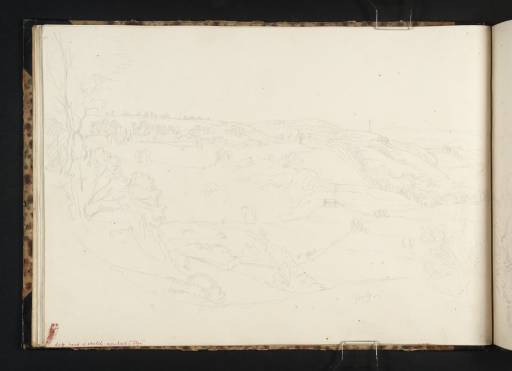Joseph Mallord William Turner Gibside and the Derwent Valley from Winlaton Scar 1817
Image 1 of 2
Joseph Mallord William Turner,
Gibside and the Derwent Valley from Winlaton Scar
1817
Joseph Mallord William Turner 1775–1851
Folio 9 Verso:
Gibside and the Derwent Valley from Winlaton Scar 1817
D12267
Turner Bequest CLVI 5a
Turner Bequest CLVI 5a
Pencil on white wove paper, 232 x 328 mm
Watermark ‘J Whatman | 1816’
Inscribed by Turner in pencil ‘Wood’, ‘Grass’, ‘[?Stone]’, and ‘Broom’, at relevant points from left of centre towards bottom left, and ‘Grass’ towards bottom right
Inscribed by John Ruskin in red ink ‘Left hand of sketch marked “Glen”’ bottom left
Watermark ‘J Whatman | 1816’
Inscribed by Turner in pencil ‘Wood’, ‘Grass’, ‘[?Stone]’, and ‘Broom’, at relevant points from left of centre towards bottom left, and ‘Grass’ towards bottom right
Inscribed by John Ruskin in red ink ‘Left hand of sketch marked “Glen”’ bottom left
Accepted by the nation as part of the Turner Bequest 1856
References
1909
A.J. Finberg, A Complete Inventory of the Drawings of the Turner Bequest, London 1909, vol.I, p.447, CLVI 5a, as ‘Another view of Gibside, near Swalwell, on River Derwent’.
1994
[Evelyn Joll], Watercolours by J.M.W. Turner R.A. (1775 – 1851), exhibition catalogue, Thos Agnew & Sons, London 1994, p.[10] under no.3.
2006
Michael Rudd, ‘Retracing Turner’s Sketching Tours: A Topographical Journey’ in Emma House, Michael Rudd and Paul Clark, Joseph Mallord William Turner: Tours of Durham and Richmondshire, exhibition catalogue, Bowes Museum, Barnard Castle 2006, p.46, as sketch of ‘Gibside from the north’ pl.34 (left-hand side, as ‘Gibside from the South’).
2006
Michael Rudd, ‘Gibside – from Sketch to Engraving’, Turner Society News, no.102, March 2006, p.6.
This is half of a panoramic view looking from the north-east over the Derwent Valley towards Gibside, continuing to the right on folio 10 recto opposite (D12268; CLVI 6). On the present page, having passed below Turner’s vantage point on Winlaton Scar, the River Derwent runs over High Dam beside a retaining wall towards the bottom centre, before curving away left to the south-east; a mill race also ran from that point towards Winlaton Ironworks to the north.1
On the hillside toward the top left is the medieval Old Hollinside manor house, seen in isolation on the recto of this leaf (D12266; CLVI 5); it had been incorporated into the Gibside estate in 1730.2 Looking up the valley to the south-west (the river being shown flowing from that direction on the opposite page), the Gibside estate continues along the hills, with the Column of British Liberty rising above the long north front of the house.
The open area towards the bottom right is Goodshields Haugh, bounded on three sides by the Derwent. Having been used for coal-mining waste, it was landscaped in the 1990s, but comparison with the 1857 Ordnance Survey map has confirmed Turner’s accuracy – including his placing of a cottage near the centre of the page, marked on the Victorian map as ‘old walls’.3 The now-redundant Derwent Valley Railway was subsequently routed along the fourth side below Old Hollinside, over a nine-arched viaduct which crosses the river below the house at Gibside, directly in Turner’s line of sight.
More than a third of the left-hand side of the sketch was disregarded in the composition of the subsequent watercolour (Bowes Museum, Barnard Castle),4 in which Old Hollinside is consequently not shown. Most of the double-page view is repeated from a nearby position on folio 10 verso (D12269; CLVI 6a). Evelyn Joll has dated the drawing as ‘probably’ from the week of 23–29 October 1817,5 although this is perhaps too literal an interpretation of Turner’s November 1817 letter recounting his recent movements (see the introduction to the tour).
Further studies of Gibside and the surrounding landscape are on folios 6 verso to 8 verso, 11 recto and 11 verso (D40723, D12265, D40724, D12270, D12271, D12272, D12273; CLVI 3 verso–4, [4 verso]–7, 7a, 8, 8a). See the introduction to the tour and the entry for folio 6 verso (D40723) for more on the history of the house and estate.
Technical notes:
There is a prominent red ink blot above Ruskin’s inscription. The other half of the drawing is indeed inscribed ‘Glen’, as he notes.
Matthew Imms
February 2010
How to cite
Matthew Imms, ‘Gibside and the Derwent Valley from Winlaton Scar 1817 by Joseph Mallord William Turner’, catalogue entry, February 2010, in David Blayney Brown (ed.), J.M.W. Turner: Sketchbooks, Drawings and Watercolours, Tate Research Publication, December 2012, https://www


